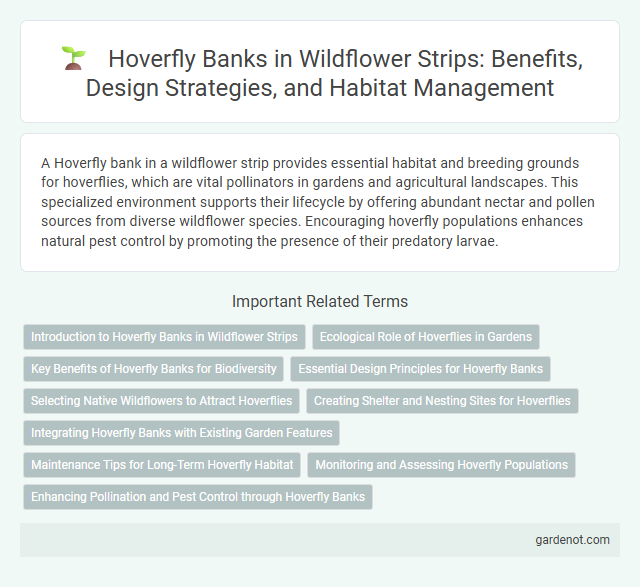A Hoverfly bank in a wildflower strip provides essential habitat and breeding grounds for hoverflies, which are vital pollinators in gardens and agricultural landscapes. This specialized environment supports their lifecycle by offering abundant nectar and pollen sources from diverse wildflower species. Encouraging hoverfly populations enhances natural pest control by promoting the presence of their predatory larvae.
Introduction to Hoverfly Banks in Wildflower Strips
Hoverfly banks are specially designed mounds of flowering plants within wildflower strips that attract hoverflies for natural pest control and pollination. These banks support hoverfly larvae, which feed on aphids and other crop pests, enhancing biodiversity and improving crop health. Incorporating hoverfly banks into agricultural landscapes promotes sustainable farming practices by reducing reliance on chemical pesticides.
Ecological Role of Hoverflies in Gardens
Hoverfly banks serve as vital habitats that support hoverflies, which play a crucial ecological role in garden ecosystems by acting as effective pollinators and natural pest controllers. These insects consume aphids and other harmful pests during their larval stage, significantly reducing the need for chemical pesticides. Promoting hoverfly populations through dedicated banks enhances biodiversity and supports sustainable garden health by maintaining balanced ecological interactions.
Key Benefits of Hoverfly Banks for Biodiversity
Hoverfly banks enhance biodiversity by providing essential breeding habitats for multiple hoverfly species that act as natural pollinators and pest controllers. These structures support diverse plant species, improving ecosystem resilience and promoting balanced food webs. Increased hoverfly populations contribute to higher crop yields through effective pollination and biological pest suppression.
Essential Design Principles for Hoverfly Banks
Hoverfly banks require a sunny location with well-drained soil and a gentle slope to provide optimal habitat conditions. Incorporate a mix of native wildflowers that bloom throughout the season to supply nectar and pollen, supporting hoverfly populations. Ensure structural diversity by including bare patches and low vegetation to facilitate breeding and shelter opportunities essential for hoverfly lifecycle.
Selecting Native Wildflowers to Attract Hoverflies
Selecting native wildflowers such as yarrow (Achillea millefolium), wild carrot (Daucus carota), and goldenrod (Solidago spp.) creates an ideal hoverfly bank that supports pollination and natural pest control. These native plants provide essential nectar and pollen resources, encouraging hoverflies to thrive and maintain ecological balance. Incorporating a diverse mix of wildflowers maximizes habitat suitability and ensures sustained hoverfly populations throughout the growing season.
Creating Shelter and Nesting Sites for Hoverflies
Hoverfly banks planted within wildflower strips provide essential shelter and nesting sites that support hoverfly populations by offering dense vegetation and bare soil patches ideal for egg-laying. These habitats enhance hoverfly biodiversity, promoting natural pest control through their predatory larvae. Incorporating native wildflowers known to attract hoverflies ensures year-round resource availability and habitat stability.
Integrating Hoverfly Banks with Existing Garden Features
Hoverfly banks strategically integrated with garden features such as wildflower strips enhance pollination and natural pest control by providing essential habitats for hoverflies. Placing these banks alongside existing plantings or near water sources optimizes hoverfly activity and supports biodiversity within the garden ecosystem. This integration promotes a balanced environment, boosting both garden health and aesthetic appeal.
Maintenance Tips for Long-Term Hoverfly Habitat
Maintaining a hoverfly bank within a wildflower strip involves regular monitoring to ensure a diverse range of native flowering plants that bloom sequentially throughout the growing season, providing continuous nectar and pollen sources. Control invasive species and avoid the use of pesticides to foster a healthy habitat, while mowing only once a year in late autumn to preserve larval overwintering sites. Soil moisture management is crucial, with a preference for well-drained soil and occasional watering during prolonged dry spells to support hoverfly populations year-round.
Monitoring and Assessing Hoverfly Populations
Hoverfly banks integrated within wildflower strips provide essential habitats supporting diverse hoverfly species crucial for pollination and pest control. Systematic monitoring through transect counts and capture-release techniques enables accurate assessment of hoverfly population dynamics and species richness. Data from these assessments inform adaptive management practices that optimize habitat conditions, ensuring sustainable hoverfly biodiversity and ecological benefits.
Enhancing Pollination and Pest Control through Hoverfly Banks
Hoverfly banks are strategically designed wildflower strips that attract and support hoverflies, essential pollinators and natural predators of aphids. By planting diverse native wildflowers, these banks increase hoverfly populations, improving crop pollination and reducing pest outbreaks naturally. Enhanced hoverfly activity contributes to sustainable agriculture by minimizing the need for chemical pesticides and promoting biodiversity.
Hoverfly bank Infographic

 gardenot.com
gardenot.com